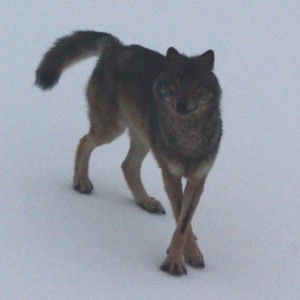The U.S. Fish and Wildlife Service will review whether or not Southeast Alaska wolves should be listed for protection under the Endangered Species Act. The federal agency this month announced what’s called a “positive 90-day finding” on a petition to list the Alexander Archipelago wolf.
Steve Brockmann is Southeast Alaska coordinator for the U.S. Fish and Wildlife Service. “We determined that there was substantial information presented, enough to make us think we probably should do a real status review,” Brockmann said Friday. He said the status review will look at the best available information on wolf populations.

The timing of when the review happens also depends on funding granted by Congress which limits the number of petitions the agency can review each year. “Recently that has been several years before we get that funding so we do have an opportunity here to well really take advantage of the time lag to get some conservation in place so we don’t have to list the wolf,” Brockmann said. “Honestly the Fish and Wildlife Service would prefer to leave management of the wolf with the state of Alaska where it belongs. We do have a responsibility to list it if it needs to be listed. We intend to work with our partners with the state and the Forest Service to make sure we don’t have to do that when the time comes.”
The petition to list the wolves was submitted in August of 2011 by two groups, the Center for Biological Diversity and Greenpeace. “Well we’re thrilled to finally have the finding. It’s come over two years late but we knew there was a strong case for pursuing a listing and we’re glad to see that the agency’s decided that our petition had merit,” said Larry Edwards, a forest campaigner with Greenpeace in Sitka.
The groups argue that the region’s wolf populations are declining and are vulnerable to hunting and trapping pressure along with loss of habitat from logging on the 17-million acre Tongass National Forest. In particular, they cite past and future logging on Prince of Wales Island and say wolves on POW are in danger of extinction. State and federal managers closed hunting and trapping seasons in late March on Prince of Wales Island because hunters and trappers had reached a target number of wolves on the island.
That’s a concern for Edwards. “We have some great concerns with how the harvest cap was set for that. We think it was set way too high and the illegal take of wolves wasn’t adequately taken into account. So there’s some significant management problems both in terms of logging and I think how Fish and Game has been managing as well.”
The groups also say two intensive management programs authorized by the state’s Board of Game last year for areas near Ketchikan and Petersburg will put further pressure on wolf numbers.
Doug Vincent-Lang is director for the Alaska Department of Fish and Game’s Division of Wildlife Conservation. He said Fish and Game believes the department has sustainably managed wolves in the region. “We’re confident that any potential conservation concerns can be adequately addressed through existing mechanisms, including state regulatory mechanisms that are out there. Given that we don’t believe that wolves in Alaska are at risk now or threatened with the risk of extinction in the foreseeable future and as such we don’t believe that there’s a justification for a 90-day positive finding for wolves in Southeast Alaska and we’re disappointed with the service’s decision.”
The intensive management programs could mean state sponsored trapping of wolves in the two areas of Southeast, designed to improve the numbers of wolves’ main prey, deer. Vincent-Lang noted the two intensive management programs have not been implemented yet. “Part of the reason is that we’re collecting additional information, both on deer and wolf in those two small areas where the board had approved intensive management programs for the Department to conduct once we had that baseline information. We’ve invested a significant amount of money in the next 3-4 years to inform the development of a status review, which this 90-day finding kicks off in terms of looking at wolf abundance, wolf distribution and wolf genetic structure in Southeast Alaska.”
The finding kicks off a 60-day public comment period beginning March 31st. Fish and Wildlife will seek input and information on Southeast wolves. At a later date, the federal agency then begins a 12-month status review which leading to a decision on whether the animals should be listed as threatened or endangered. The agency determined a listing was not warranted for a prior petition submitted during the 1990s.
Joe Viechnicki is a reporter at KFSK in Petersburg.




